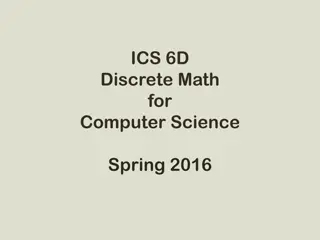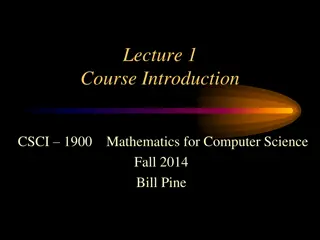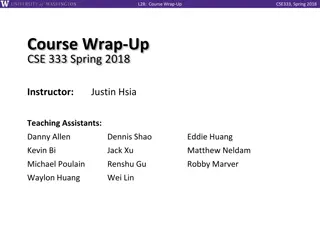
Optimizing Coin Change and Interval Scheduling Algorithms
Explore the optimality of greedy algorithms in coin change and interval scheduling problems. Learn how to minimize the number of coins needed for change and maximize job processing with non-overlapping intervals. Understand when the greedy algorithm works and when dynamic programming may be a better solution.
Download Presentation

Please find below an Image/Link to download the presentation.
The content on the website is provided AS IS for your information and personal use only. It may not be sold, licensed, or shared on other websites without obtaining consent from the author. If you encounter any issues during the download, it is possible that the publisher has removed the file from their server.
You are allowed to download the files provided on this website for personal or commercial use, subject to the condition that they are used lawfully. All files are the property of their respective owners.
The content on the website is provided AS IS for your information and personal use only. It may not be sold, licensed, or shared on other websites without obtaining consent from the author.
E N D
Presentation Transcript
More Greedy; Course wrap-up CSE 417 Winter 24 Lecture 27
Change-Making Suppose you need to make change with the fewest number of coins possible. Greedy algorithm: Take the biggest coin less than the change remaining. Is the greedy algorithm optimal if you have 1 cent coins, 10 cent coins, and 15 cent coins? What about for U.S. coinage (1, 5, 10, 25, 50, 100)
Change-Making Suppose you need to make change with the fewest number of coins possible. Take the biggest coin less than the change remaining. Is the greedy algorithm optimal if you have 1 cent coins, 10 cent coins, and 15 cent coins? What about for U.S. coinage (1, 5, 10, 25, 50, 100)
Change-Making The greedy algorithm doesn t always work! We forced you to observe that in a homework problem for those that did it. But there are times where it does For standard US coinage, the greedy algorithm works And it also always works if your coins always exactly double in value. Another reason to be very careful with greedy algorithms! Also a good example of how you can sometimes avoid greedy if you can t figure out a proof maybe there s a way to write a DP instead!
Interval Scheduling You have a single processor, and a set of jobs with fixed start and end times. Your goal is to maximize the number of jobs you can process. I.e. choose the maximum number of non-overlapping intervals.
Interval Scheduling You have a single processor, and a set of jobs with fixed start and end times. Your goal is to maximize the number of jobs you can process. I.e. choose the maximum number of non-overlapping intervals. 3 non-overlapping intervals
Interval Scheduling You have a single processor, and a set of jobs with fixed start and end times. Your goal is to maximize the number of jobs you can process. I.e. choose the maximum number of non-overlapping intervals. 3 other non- overlapping intervals
Interval Scheduling You have a single processor, and a set of jobs with fixed start and end times. Your goal is to maximize the number of jobs you can process. I.e. choose the maximum number of non-overlapping intervals. OPT is 3 there is no way to have 4 non-overlapping intervals; both the red and purple solutions are equally good.
Greedy Ideas To specify a greedy algorithm, we need to: Order the elements (intervals) Choose a rule for deciding whether to add. Rule: Rule: Add interval as long as it doesn t overlap with those we ve already selected. What ordering should we use? Think of at least two at least two orderings you think might work.
Greedy Algorithm Some possibilities Earliest end time (add if no overlap with previous selected) Latest end time Earliest start time Latest start time Shortest interval Fewest overlaps (with remaining intervals)
Greedy That list slide is the real difficulty with greedy algorithms. All of those look at least somewhat plausible at first glance. With MSTs that was fine those ideas all worked! It s not fine here. They don t all work. As a first step try to find counter-examples to narrow down
Greedy Algorithm Earliest end time Latest end time Earliest start time Latest start time Shortest interval Fewest overlaps (with remaining intervals)
Take Earliest Start Time Counter Example Algorithm finds Optimum Taking the one with the earliest start time doesn t give us the best answer.
Shortest Interval Algorithm finds Optimum Taking the shortest interval first doesn t give us the best answer
Greedy Algorithm Earliest end time Latest end time Earliest start time Latest start time Shortest interval Fewest overlaps (with remaining intervals)
Earliest End Time Intuition: If ? has the earliest end time, and ? overlaps with ? and ? then ? and ? also overlap. Why? If ? and ?overlap, then both are active at the instant before ? ends (otherwise ? would have an earlier end time). Otherwise ? would have an earlier end time than ?! By the same reasoning, ?is also active the instant before ? ends. So ? and ? also overlap with each other.
Earliest End Time Can you prove it correct? Do you want to use Structural Result Exchange Argument Greedy Stays Ahead
Exchange Argument Let ? = ?1,?2, ,?? be the set of intervals selected by the greedy algorithm, ordered by endtime OPT= ?1,?2, ,? be the maximum set of intervals, ordered by endtime. Our goal will be to exchange to show ? has at least as many elements as OPT. Let ??,?? be the first two elements where ?? and ??aren t the same. Since ?? 1 and ?? 1 are the same, neither ?? nor ?? overlaps with any of ?1, ,?? 1. And by the greedy choice, ?? ends no later than ?? so ??doesn t overlap with ??+1. So we can exchange ?? into OPT, replacing ?? and still have OPT be valid.
Exchange Argument Repeat this argument until we have changed OPT into ?. Can OPT have more elements than ?? No! After repeating the argument, we could change every element of OPT to ?. If OPT had another element, it wouldn t overlap with anything in OPT, and therefore can t overlap with anything in ? after all the swaps. But then the greedy algorithm would have added it to ?. So ? has the same number of elements as OPT does, and we really found an optimal
Greedy Stays Ahead Let ? = ?1,?2, ,?? be the set of intervals selected by the greedy algorithm, ordered by endtime OPT= ?1,?2, ,? be the maximum set of intervals, ordered by endtime. Our goal will be to show that for every ?, ?? ends no later than ??. Proof by induction: Base case: ?1 has the earliest end time of any interval (since there are no other intervals in the set when we consider ?1 we always include it), thus ?1 ends no later then ?1.
Greedy Stays Ahead Inductive Hypothesis: Suppose for all ? ?, ??ends no later than ??. IS: Since (by IH) ?? ends no later than ??, greedy has access to everything that doesn t overlap with ??. Since ?? ends no later than ??, that includes ??+1.Since we take the first one that doesn t overlap, ??+1 will also end before ??+1. Therefore ??+1 ends no later than ??+1 Wrapping Up: Since every ?? ends no later than ??, the last interval greedy selects (??) is no later than ??. There cannot be an ??+1, as if it didn t overlap with ??it also wouldn t overlap with ?? and would have been added by greedy.
Greedy Algorithm Earliest end time Latest end time Earliest start time Latest start time Shortest interval Fewest overlaps (with remaining intervals)
Other Greedy Algorithms It turns out latest start time also works. Latest start time is actually the same as earliest end time (imagine reflecting all the jobs along the time axis the one with the earliest end time ends up having the last start time). What about fewest overlaps? Doesn t work!
Fewest Overlaps counter-example ALG OPT The top middle item will be selected first, eliminating the chance of getting the 4 intervals in OPT.
Greedy Algorithm Earliest end time Latest end time Earliest start time Latest start time Shortest interval Fewest overlaps (with remaining intervals)
Summary Greedy algorithms You ll probably have 2 (or 3 or 6) ideas for greedy algorithms. Check some simple examples before you implement! Greedy algorithms rarely work. When they work AND you can prove they work, they re great! Proofs are often tricky Structural results Structural results are the hardest to come up with, but the most versatile. Greedy stays ahead Greedy stays ahead usually use induction Exchange Exchange start with the first first difference between greedy and optimal.
Which Technique? When I see a new problem, how do I know which option to use? Try modeling first use the problems we ve already solved Preferences? Try stable matching. Assignments? Try network flow. Etc.
Which Technique? Modeling Didn t work? What does this remind you of? Then try: recursive thinking (will lead to DP or D&C) Ask how you would represent the problem visually (might lead to graphs) Finally: remember your problem might be hard!
Weve Covered A LOT Stable Matchings Proof fundamentals Modifications of BFS/DFS Divide & Conquer Dynamic Programming LPs Network Flow (and assignment problems) Reductions, P vs. NP Coping with NP-completeness Greedy algorithms
What Comes next? CSE 417 is intended as a last undergraduate course for those of you about to graduate. But if you are hoping for more, consider: CSE 422 (toolkit for modern algorithms) Mathematics and algorithms for larger data sets/ML, approximate solutions CSE 521 (Graduate algorithms) More math background expected, more approximation algorithms, and a few other topics. CSE 431 (Complexity theory) Proof-based (all your homework problems are proofs). More on NP, undecidability, other notions of hard. Courses in Math & AMATH (especially for LPs and network flow) Math 461, 462 (combinatorics); Math 407, 408 (LPs, convex optimization); Math 409 (lots of overlap with this course) Math 514 (deep theory behind LPs, MSTs, etc.)
Resources Cracking the Coding Interview (McDowell) or another book like it. Copies are at the library! General Advice from Kasey Champion Leetcode (we borrowed more than one homework problem from there). General resume advice (and other resources). Some specific to Allen School.
Technical Questions Your interviewer wants to see 1. What you know 2. Can you communicate technical ideas 3. Can you problem-solve Getting the right solution helps with point 1. Not points 2 and 3. You also need to talk through what you see in the problem/how you solve it. The best way is to practice. Find a friend, a set of interview questions, and a whiteboard and practice.
Technical Questions Show you can problem-solve. It s tempting to skip the problem-solving steps if you know the answer. It s a good idea to still do all of them. You can go quicker, but give them something. Don t feel obligated to use this exact method others exist, but you should hit these points. Even if you know the best algorithm from the Even if you know the best algorithm from the time you read the problem statement. time you read the problem statement.
A sample Problem: https://leetcode.com/problems/house-robber/ You are a professional robber planning to rob houses along a street. Each house has a certain amount of money stashed, the only constraint stopping you from robbing each of them is that adjacent houses have security systems connected and it will automatically contact the police if two adjacent houses were broken into on the same night. Given an integer array nums representing the amount of money of each house, return the maximum amount of money you can rob tonight without alerting the police.
TEBOW IT Talk Example Baseline (aka Brute Force) Optimize Walk-Through Implement Test https://commons.wikimedia.org/wiki/File:Tim_Tebow_in_the_dugout.jpg Tim Tebow: Football player turned football analyst turned simultaneous-baseball-player- and-football-analyst turned football player turned football analyst again. Acronym from Kasey Champion; similar process in Cracking the Coding Interview
Talk Make sure you understand every technical term in the prompt (if any). Ask questions to make sure you ve got the idea. Ask about simplifying assumptions. Pick out any key pieces of the problem You are a professional robber planning to rob houses along a street. Each house has a certain amount of money stashed, the only constraint stopping you from robbing each of them is that adjacent houses have security systems connected and it will automatically contact the police if two adjacent houses were broken into on the same night. Given an integer array nums representing the amount of money of each house, return the maximum amount of money you can rob tonight without alerting the police.
Talk If I enter houses 2 and 4 only, I don t set off an alarm, right? The houses are just in a line, I m only worrying about one side of the street? I m planning just one night? The amount of money is an integer? Can it be negative? I don t have to record which houses, just the final number? You are a professional robber planning to rob houses along a street. Each house has a certain amount of money stashed, the only constraint stopping you from robbing each of them is that adjacent houses have security systems connected and it will automatically contact the police if two adjacent houses were broken into on the same night. Given an integer array nums representing the amount of money of each house, return the maximum amount of money you can rob tonight without alerting the police.
Talk Self-checks Do I know the method signature (inputs and return type)? Is there any information in the prompt that I feel is useless? There usually isn t any, so maybe ask a question about that
Example Make a sample input or two, find the answer and confirm it s right with the interviewer the interviewer confirm it s right with
Baseline First algorithm that comes to mind. Doesn t matter how slow.[1] This is a good problem solving technique, sometimes you want to optimize the first thing you think of. Sometimes you don t, but it s still useful for you as a human. You re going to be nervous. It s a lot easier to think creatively with the baseline in your back pocket. You won t end this interview having written no code. [1] ok, it does matter how slow, but that s not the point yet yet
Baseline If you see what to do right away that s fine! You can short-circuit this step. But if it doesn t work come back here! I don t like to spend more than a few minutes with no back-up plan. Remember the examples you did! Those can help now. Were you doing a brute force on those to solve them?
Baseline Well I guess we could check all 2? sets of houses. Will be really slow, but will work. Let s try to do better.
Optimize Now, let s get a better algorithm. What did you see in your examples? What does this remind you of? We re finding the maximum something in an array, that might remind you of maximum subarray sum. Maybe DP? Let s start there
Optimize Let s think recursively. Start with the last house. We re currently thinking about house ?. If we want to include ?, then we want If we want to exclude ?then we want
Optimize Let s think recursively. Start with the last house. We re currently thinking about house ?. If we want to include ?, then we want If we want to exclude ?then we want
Optimize Let s think recursively. Start with the last house. We re currently thinking about house ?. If we want to include ?, then we want The best robbing plan from 0 to ? 2 If we want to exclude ?then we want The best robbing plan from 0 to ? 1. We don t have to include ? 1 through. Let OPT be the value of the best robbing plan for the array from 0 to ?.






















